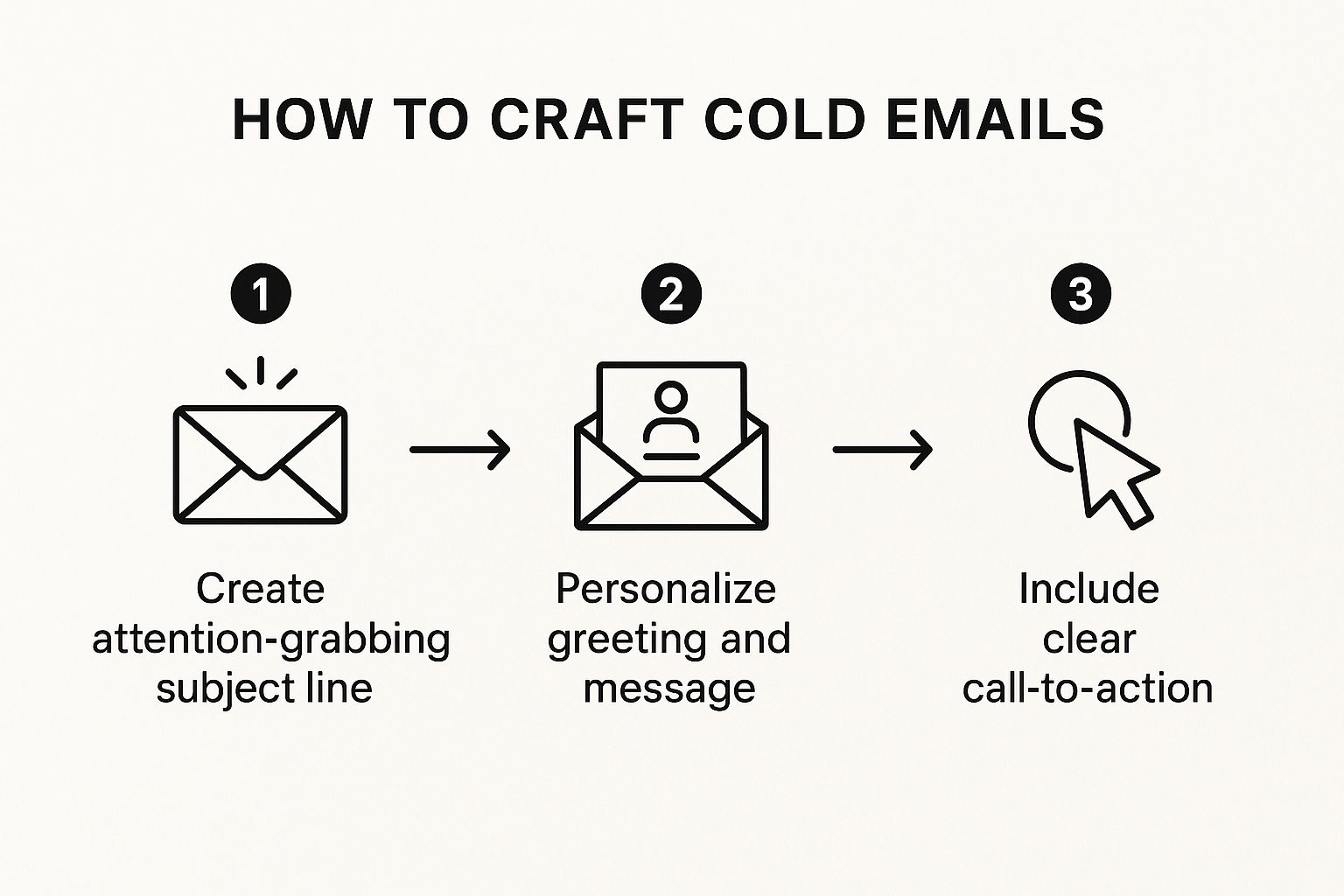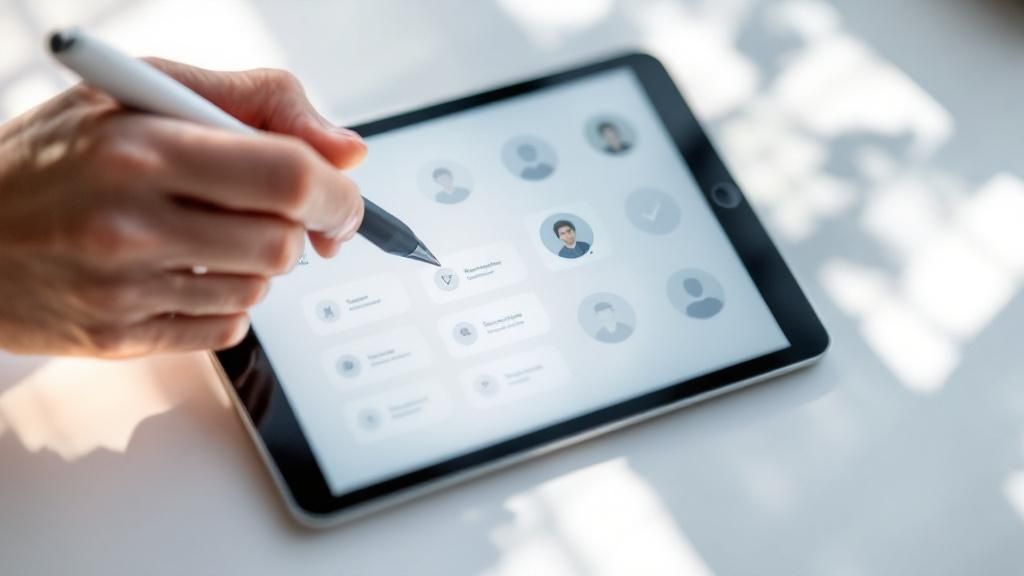Let's be honest, outbound lead generation used to be a game of brute force. It was all about volume. But those days are long gone. Today, it’s about intelligent precision—swapping out the old mass-market megaphone for a highly-tuned, personalized approach that actually connects with high-quality leads.
The New Rules of Outbound Lead Generation

The old outbound playbook has been completely rewritten. Remember making hundreds of calls or blasting thousands of identical emails? That’s now a relic. The modern strategy is all about relevance and value. The entire focus has shifted from what you sell to how you solve a prospect's very specific problem.
This wasn't some optional evolution. It was a change born out of necessity. The effectiveness of traditional tactics like cold calling just fell off a cliff, with conversion rates bottoming out at around 2%. This miserable return forced a major pivot in the B2B world toward personalization, multi-channel sequences, and a serious reliance on data-driven insights.
Moving Beyond the Cold Call
Successful sales teams today get it: interrupting a prospect’s day with a generic pitch is a fast track to getting ignored. Instead, they build campaigns that weave together touchpoints across multiple channels, creating a narrative that feels helpful, not intrusive.
This modern approach is built on a totally new foundation:
- Hyper-Personalization: Using real data to tailor messages that speak to a prospect’s specific role, recent company news, or even the tech stack they use.
- Multichannel Cadence: Engaging prospects with a thoughtful sequence of emails, LinkedIn interactions, and well-timed, strategic phone calls.
- Value-First Approach: Offering genuine insights, helpful resources, or potential solutions before you ever ask for a meeting.
The real goal here is to warm up the "cold" outreach. By the time you make a direct ask, the prospect should already recognize your name and understand the value you bring because you've proven it at every single touchpoint.
Technology as the Great Enabler
This shift simply wouldn't be possible without technology. Sales intelligence platforms and AI-powered tools aren't just a nice-to-have anymore; they're essential for any competitive team. They give you the data to pinpoint high-intent prospects and the automation to engage them at scale without losing that critical personal touch.
Think about it. A sales team can now instantly identify companies that just got a round of funding, hired a new VP, or started using a technology that complements their own. This intel allows them to craft a message that is not only personalized but also perfectly timed. Suddenly, a cold outreach becomes a relevant, timely conversation.
To give you a clearer picture of how much things have changed, here’s a quick comparison of the old vs. new way of thinking about outbound.
Outbound Lead Generation Then vs Now
| Attribute | Traditional Approach | Modern Approach |
|---|---|---|
| Focus | Product-centric; "What we sell" | Problem-centric; "How we solve your issue" |
| Methodology | High-volume, low-personalization | Low-volume, high-personalization |
| Channels | Primarily single-channel (phone, email) | Multichannel (email, social, phone, video) |
| Data Usage | Basic contact lists | Deep data insights (intent, triggers, tech stack) |
| Mindset | Transactional, interruptive | Relational, value-driven |
This table really highlights the strategic leap from a purely transactional game to a relationship-building one. It's about earning attention, not just demanding it.
If you’re looking to go deeper into the foundational strategies of this modern approach, a comprehensive Outbound Marketing Guide can be a huge help. This isn't just a minor tweak to old tactics; it’s a fundamental change in how businesses connect with their future customers by focusing on relationships, not just filling a pipeline.
How to Build Your Ideal Customer Profile
Let's be blunt: effective outbound hinges on one non-negotiable principle. You must know who you’re talking to. Spraying and praying is just a fast way to burn through your budget and morale.
Real success starts with building a laser-focused Ideal Customer Profile (ICP). And no, this isn't just about listing basic company details.
Think of your ICP as a living document, a detailed description of the perfect-fit company for your product. It’s the compass for your entire outbound strategy, making sure every email and every call is aimed at a genuine opportunity. Without a clear ICP, you’re just taking shots in the dark.
Going Beyond Basic Firmographics
Most sales teams start and, unfortunately, stop with firmographics—things like industry, company size, and location. While that's a decent starting point, it's only scratching the surface. A truly powerful ICP for outbound digs much deeper to find companies that aren't just a good fit on paper, but are also primed to buy.
Here are the layers you absolutely need to add:
- Technographics: What’s in their current tech stack? Knowing they use a competitor's product or a complementary tool gives you an incredible angle for your outreach. It's an instant "in."
- Buying Intent Signals: These are the behavioral clues that scream "we're looking for a solution!" This could be anything from a spike in their team's online research around specific keywords to recent, relevant new hires.
- Trigger Events: Did they just close a new round of funding? Hire a new VP of Sales? Announce an expansion? These events almost always create new needs and fresh budget, making it the perfect time to connect.
A great ICP doesn’t just tell you who to target; it tells you why and, most importantly, when. It turns a cold interruption into a timely, relevant conversation about a problem they're likely trying to solve right now.
For example, imagine you sell HR software. You could target every company with 500+ employees. Or, you could target companies that just posted a job for a "Head of People Operations." That job posting is a massive trigger event—a clear signal they're scaling and need better HR systems. Which approach do you think will work better?
Building Your High-Quality Lead List
Okay, so your ICP is sharp and defined. Now what? The next step is to build the actual list of companies and contacts. This is where so many outbound campaigns fall flat. A cheap, outdated list will sink your efforts before you even send the first email.
I can't stress this enough: quality over quantity. A list of 100 hyper-qualified, ICP-fit prospects is infinitely more valuable than a sloppy list of 10,000 random contacts.
To build this kind of targeted list, you need the right tools and data sources. I've found that layering data from a few different platforms gives the best, most accurate results.
My Go-To Tools for Lead Sourcing
| Tool Type | Example | How I Use It |
|---|---|---|
| Sales Intelligence | LinkedIn Sales Navigator | Essential for filtering companies by size, industry, and location. Perfect for zeroing in on the right decision-makers in target accounts. |
| B2B Data Providers | ZoomInfo, Apollo.io | This is where I get the goods: verified emails, direct dials, and rich company data like technographics and intent signals. |
| Niche Databases | Industry-specific directories | Great for finding companies in very specific verticals that the big databases might overlook. Think trade association member lists. |
By combining these sources, you can build a truly robust list. I'll often start on LinkedIn to identify target companies and key people, then use a tool like Apollo.io to enrich that list with verified contact info and recent buying signals.
This simple infographic really nails the flow of using this data to craft cold emails that actually work.

It breaks outreach down into its core parts—attention, personalization, and action. And guess what? Every single one of them relies on the quality of your initial ICP and lead list.
Getting this foundation right is the first major step toward building a predictable and profitable outbound machine. For a wider view on how this piece fits into the puzzle, you can read more on B2B sales lead generation and see how different strategies come together.
Crafting Outreach That Actually Gets Replies

This is where all your careful planning finally meets the real world. A perfect ICP and a clean lead list are fantastic, but they don't mean much if your outreach falls flat. Let's be honest: cutting through the digital noise today is tough. Success hinges on sending messages that feel human, helpful, and are genuinely hard to ignore.
Forget the stale, robotic templates that everyone’s inbox is full of. The real goal is to start a conversation, not just blast a pitch. Every single touchpoint, whether it's your first email or a follow-up on LinkedIn, needs to provide some kind of standalone value.
Designing a Multichannel Sequence
A single cold email is easy to delete and forget. A thoughtful, multichannel sequence, on the other hand, builds familiarity and shows you're serious. This isn't about spamming people on every platform you can find. It’s about orchestrating a series of gentle nudges that fit how people actually work and communicate.
Here’s a simple but effective sequence I often use as a starting point:
- Day 1 (Email): The first touch. This needs to be highly personalized. Reference something specific from your research—a trigger event, a recent company announcement, anything. Keep it short, focus on one pain point, and end with a soft CTA, like simply asking if they're the right person to talk to.
- Day 3 (LinkedIn): Send a connection request. That's it. No pitch in the message. Your name and company are visible, creating a subtle second touchpoint that backs up your email.
- Day 5 (Email): Follow up with a new piece of value. This could be anything from a relevant case study, a short video explaining a concept, or even a one-sentence tip that solves a tiny problem they might have.
- Day 7 (LinkedIn): Engage with their content. A simple like or a thoughtful comment on a post they shared shows you're paying attention and you aren't just an automation bot. The goal is to become a familiar name, not a stranger.
- Day 10 (Call): Now you can make a brief, well-researched call. Your opener can reference your previous outreach. Something like, "Hi [Name], I sent an email last week about [topic] and just saw your LinkedIn post on [their post's topic]. Figured a quick call might be easier."
This cadence respects their time while keeping you on their radar. The mix of passive touches (LinkedIn engagement) and active outreach (emails, calls) makes the whole interaction feel much warmer.
The Art of Human-Sounding Copy
How you say something is just as important as what you say. Prospects can spot a generic template from a mile away. To write copy that actually gets replies, you need to sound like one human writing to another.
Key Insight: The best outbound messages don't read like marketing copy. They read like a helpful email you'd send to a colleague. They are concise, clear, and focused on the recipient, not on you.
This move toward genuine personalization isn’t just a hunch; it's backed by data. Nearly 80% of marketers see that customers expect more personalized engagement, forcing everyone to adapt their strategies. This is a major trend in outbound lead generation at lemlist.com, where AI-powered tools are now key to personalizing emails dynamically, boosting engagement, and staying out of spam folders.
Here’s a quick before-and-after to show you what I mean:
| Outreach Style | Example Opening | Why It Fails or Succeeds |
|---|---|---|
| Generic & Bad | "Hi, my name is Alex from Company X, and we provide industry-leading solutions to help businesses like yours increase revenue." | It's all about the sender ("my name is," "we provide") and filled with buzzwords. Instant delete. |
| Personalized & Good | "Hi [Name], I saw your company just secured Series B funding—congratulations. Typically, when companies scale this fast, managing [specific pain point] becomes a challenge." | It opens with a specific, relevant event and immediately ties it to a problem they're likely facing. It proves you did your homework. |
Personalization at Scale with AI
Writing that perfect email for one person is one thing. Doing it for a list of 500 is another—and frankly, it's impossible to do manually. This is where AI tools have become a complete game-changer.
Modern sales engagement platforms use AI to do some of the heavy lifting:
- Draft personalized first lines: AI can scan a prospect's LinkedIn profile or recent company news to generate a relevant opening sentence that you can then tweak.
- Suggest value props: Based on a prospect's industry and title, AI can recommend which pain points or benefits will resonate most.
- Refine your tone: Some tools can even analyze your copy and suggest small changes to make it sound more confident, casual, or helpful.
If you need a hand drafting compelling messages, exploring different prompt ideas can be a huge help. You can find some great examples in these ChatGPT prompts for digital marketers.
By pairing your solid research with AI-driven personalization, you can make every single prospect feel like you wrote a message just for them. Because, in a way, you did.
Running Your Outbound Sales Campaigns

You've got a sharp ideal customer profile and a set of compelling outreach sequences. Now comes the fun part: execution. This is where your strategy gets real, and the operational mechanics of your outbound engine start firing on all cylinders. A great plan is one thing, but a repeatable, efficient workflow is what turns that plan into a predictable source of pipeline.
Let's be honest, trying to manage a multichannel outbound campaign manually is a recipe for disaster. It's not just clunky; it's nearly impossible to do at any scale. The right technology is the backbone of any modern sales effort, freeing up your team to do what they do best—sell—instead of getting bogged down in administrative quicksand.
Assembling Your Essential Tech Stack
Your choice of tools will make or break your team's productivity and the overall punch of your outreach. At the bare minimum, you need a central command center for managing relationships and a platform to actually execute your sequences.
Here’s a look at the core components I've seen in virtually every successful outbound stack:
- Customer Relationship Management (CRM): This is your single source of truth. It's non-negotiable. A CRM like HubSpot or Salesforce is where all your prospect data lives, every interaction gets tracked, and the entire history of a relationship is stored. Think of it as the central hub that everything else plugs into.
- Sales Engagement Platform (SEP): This is the engine of your campaign. Tools like Salesloft, Outreach, or our own Salesloop.io put your outreach on autopilot. They run your email sequences, queue up follow-up tasks, and deliver the critical analytics you need to see what's actually working.
- Data Enrichment & Prospecting Tools: You can't reach out to ghosts. Platforms like ZoomInfo, Apollo.io, or LinkedIn Sales Navigator are vital for building and cleaning up your lead lists with accurate, up-to-date contact info. In my experience, high-quality prospecting on LinkedIn is often the first step in the most lucrative campaigns.
These tools shouldn't operate in silos. The goal is a seamless flow: you find prospects with your data tools, manage their journey in your SEP, and log every touchpoint back to your CRM for a complete picture.
Building a Repeatable Daily Workflow
Consistency is the name of the game in outbound. A structured daily workflow eliminates the guesswork and ensures every rep is running the same proven playbook. This isn't about micromanaging; it's about building a system for success that leads to predictable results.
A typical daily rhythm for one of our top-performing reps usually looks something like this:
- Morning Prep (30 mins): First thing, they check the SEP for the day's scheduled tasks. They scan for any overnight replies and prioritize their responses to catch prospects while they're still engaged.
- Execution Block 1 (90 mins): Time to launch. New prospects get added to sequences, scheduled calls get made, and any manual email steps are personalized and sent.
- Prospect Research (60 mins): This is dedicated time for building fresh lead lists and digging up personalization gold for tomorrow's outreach.
- Execution Block 2 (90 mins): Back to execution. This block is all about follow-ups, hitting social media engagement tasks, and nurturing warmer conversations.
- End-of-Day Wrap-Up (30 mins): Before logging off, they update the CRM with notes from calls and key interactions, then take a quick look at their performance metrics for the day.
The most productive sales teams don’t leave their day to chance. They operate within a structured framework that maximizes their high-value activities—like talking to prospects—and minimizes wasted time.
Handling Responses and Qualifying Leads
Let's face it, not every reply will be a signed contract. A huge part of running an effective outbound campaign is knowing how to manage the different kinds of responses you'll inevitably get. This is a critical filtering process that keeps your closers focused only on high-potential opportunities. To get really efficient here, you have to find ways to automate repetitive tasks like initial response sorting.
Here’s a simple system for triaging incoming replies:
| Response Type | Description | Next Action |
|---|---|---|
| Positive Reply | The prospect shows genuine interest, asks for more info, or agrees to a meeting. | This is a green light. Book the meeting immediately or answer their questions directly to keep the momentum going. |
| Neutral / Referral | They say they're not the right person but kindly point you toward a colleague. | A gift! Thank them, add the new contact to your sequence, and start the outreach process with them. |
| Objection | The classic "not interested," "no budget," or "bad timing" responses. | Don't give up. Use a pre-planned script to handle the objection gracefully and try to uncover the real issue. |
| Unsubscribe | They explicitly ask to be removed from your list. | Honor this immediately. Mark them as "Do Not Contact" in your CRM to respect their wishes and stay compliant. |
Being disciplined about qualifying these initial responses is what keeps your pipeline clean and your sales reps focused. This methodical approach to execution is what turns your outbound strategy from a bunch of random activities into a well-oiled machine that consistently generates high-quality leads.
Measuring and Optimizing Your Outbound ROI
Launching an outbound campaign without tracking what’s happening is a surefire way to burn cash and time. It's like shouting into the void and hoping for the best. You might be busy, but you have no real idea if you’re actually getting closer to a sale.
The real trick is to measure what truly matters. We're not just collecting data for the sake of it. We're creating a tight feedback loop where every single email, call, and social touchpoint feeds back into the system, making your entire outbound engine smarter and more profitable.
This is how you turn outbound from a series of hopeful guesses into a predictable pipeline of revenue.
Moving Beyond Vanity Metrics
It’s incredibly easy to get distracted by numbers that look good on a dashboard but don't actually move the needle. Open rates are the classic culprit. A 90% open rate feels fantastic, but it doesn't pay the bills. Someone can open your email, roll their eyes, and delete it in the same second.
To get a real pulse on performance, you have to track the metrics that signal genuine engagement and intent. These are the numbers that prove your message isn't just being seen—it's resonating with the right people.
Here are the core metrics that should be front and center on your dashboard:
- Reply Rate: This is your first real sign of life. It tells you how many people were compelled enough by your outreach to actually hit "reply."
- Positive Reply Rate: Even better. This slices out the "not interested" or "unsubscribe" responses, leaving you with the percentage of genuinely curious or positive replies. This is a huge indicator of message-market fit.
- Meetings Booked: Now we're talking. This is a hard number that directly links your outreach efforts to creating real sales pipeline.
- Sales Conversion Rate: The ultimate test. Of all those meetings you booked, how many actually became closed-won deals?
- Customer Lifetime Value (CLV): Think beyond the first sale. What’s the total long-term value of the customers you’re bringing in through outbound channels?
- Return on Investment (ROI): The bottom line. When you subtract the cost of your tools, data, and people from the revenue you've generated, are you in the black?
The Power of A/B Testing
Let's be honest: your first draft of a sequence is never going to be your best. The secret to killer outbound campaigns isn't finding one "perfect" message—it's the relentless process of testing and refining. It’s an ongoing discipline, not a one-and-done task.
The goal here isn't to find a single silver bullet. It's about making small, incremental improvements that compound over time. A 1% bump in your positive reply rate might feel tiny, but over thousands of prospects, that's a serious number of new meetings.
The key is to test one variable at a time. If you change the subject line and the CTA, you’ll never know which one made the difference. Keep it clean.
Here are some of the most impactful elements to A/B test in your sequences:
| Element to Test | Variant A | Variant B |
|---|---|---|
| Subject Line | Quick question about [Company Name] | Idea for your new [Job Title] role |
| Opening Line | Saw your post on LinkedIn about X. | Congrats on the recent funding round. |
| Call-to-Action | Are you free for a 15-min call next week? | Is solving [problem] a priority right now? |
| Sequence Cadence | 5 touches over 10 business days | 8 touches over 15 business days |
Keep a close eye on the performance of each variant. As soon as you have a clear winner—say, subject line B consistently crushes A on reply rates—it becomes your new "control" version. Then, you pick a new variable to test against it.
This iterative loop of testing and optimizing is what separates the amateurs from the pros. To see how this fits into a broader strategy, our guide on sales cadence best practices is a great next step.
By pairing a ruthless focus on meaningful metrics with a disciplined A/B testing framework, you start to systematically build a high-performance outbound machine. Every action is backed by data, moving you predictably toward your revenue goals.
Your Top Outbound Lead Gen Questions, Answered
Even with a killer strategy in hand, jumping into outbound lead generation can feel like exploring a new world. It's totally natural to have questions, and getting clear answers is what builds the confidence you need to launch your campaigns and really own the process.
Let's break down some of the most common hurdles I see sales teams run into when they decide to go on the offensive. Think of this as your practical guide to turning those "what if" scenarios into "I got this" moments.
How Much Is Too Much?
This is the million-dollar question, isn't it? There's a razor-thin line between being persistent and just plain pestering. The best advice I can give is to stop counting attempts and start counting value.
A solid multi-channel sequence usually lands somewhere between 8-12 touches spread across 3-4 weeks. But this isn't about spamming someone with a dozen "just checking in" emails. It's a strategic mix of different plays:
- Personalized emails that bring a new idea to the table.
- "Passive" LinkedIn touches, like a thoughtful comment or a simple like.
- A couple of well-timed, intentional phone calls.
Here's the bottom line: every single interaction needs to earn you the right to the next one. If each touchpoint offers a fresh piece of value or a new perspective, you can stay on their radar. If you’re just a broken record, you'll burn out your entire list in a week.
What If My Emails Are Going to Spam?
Email deliverability is a massive piece of the outbound puzzle. It’s incredibly frustrating to put all that work into a great message, only for it to disappear into the spam void. The good news is, you're not helpless here.
First things first: warm up your email domain before you go big. This just means sending a small number of emails and slowly ramping up the volume over a few weeks. It’s how you signal to Gmail and Outlook that you're one of the good guys.
Second, you absolutely have to verify your email lists before you hit send. Launching a campaign with old, unverified contacts is a surefire way to get a high bounce rate, which is a huge red flag for spam filters.
And finally, watch your language. Don't use spammy words (like "free" or "guarantee"), go crazy with exclamation points, or embed huge images that can get your emails flagged.
Should I Bother With Automation Tools?
The short answer is a hard yes—but with a huge asterisk. Automation is your best friend for handling the grunt work, the repetitive tasks that eat up your day. It should never, ever replace the human touch.
Let me break it down like this:
| What to Automate | What to Do by Hand |
|---|---|
| Sending the scheduled follow-ups in your sequence. | Writing that killer opening line based on their latest LinkedIn post. |
| Logging all your calls and emails in the CRM. | Crafting a custom P.S. that mentions a mutual connection or shared interest. |
| Automatically removing anyone who replies or books a meeting. | Handling a specific objection with a thoughtful, tailored response. |
Using a sales engagement platform like Salesloop.io isn't about building a robot to do your job. It's about creating a system that frees you up to personalize your outreach at scale. You automate the logistics, not the relationship.
Inbound vs. Outbound: Which One Wins?
This is a false choice. It's not "either/or"—it's "both/and." Inbound and outbound are just two different, complementary ways to drive revenue.
Inbound marketing is like setting up a really compelling shop on a busy street. You create amazing content—blogs, webinars, case studies—that draws people in when they're actively looking for help. It's incredible for building your brand and capturing leads who are already raising their hands.
Outbound lead gen, on the other hand, is like being the master networker who goes out and personally invites your ideal customers into that shop. You're not waiting around; you're proactively starting conversations with the exact high-value accounts you want to work with. This gives you predictability and direct control over your pipeline.
The smartest companies don't pick a side. They build an inbound engine that works 24/7 to attract leads, and they run a targeted outbound strategy to go after their dream accounts. It's a one-two punch that creates a truly powerful growth machine.
Ready to stop guessing and start executing a predictable outbound strategy? Salesloop.io provides the tools you need to automate your logistics, personalize your outreach at scale, and fill your pipeline with qualified meetings. Start building your outbound engine today.





